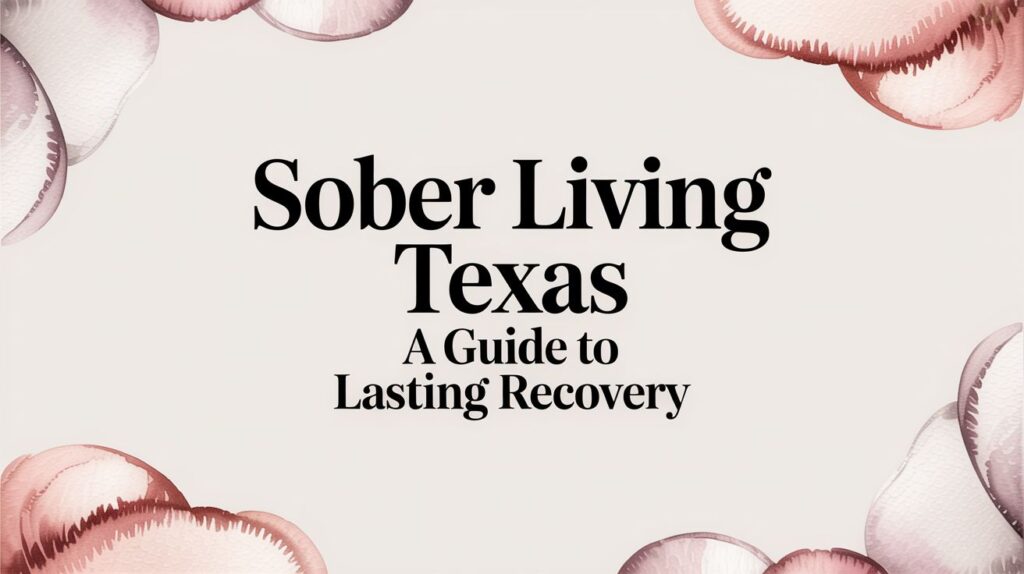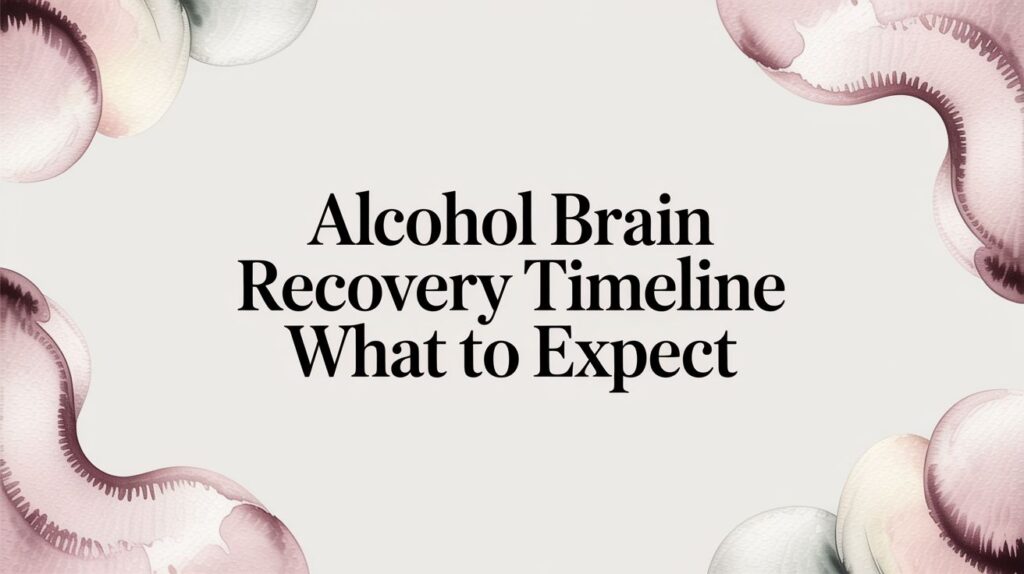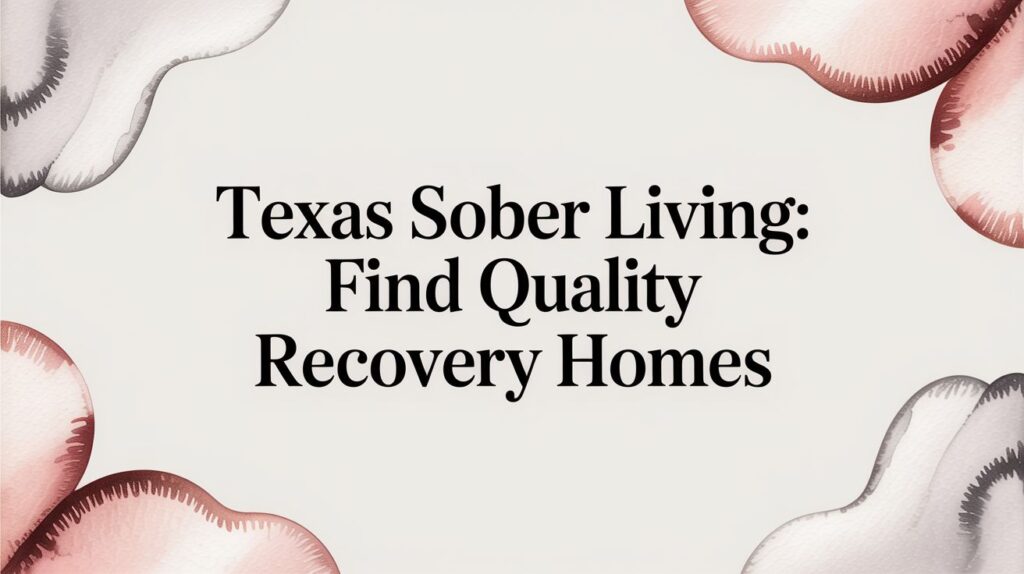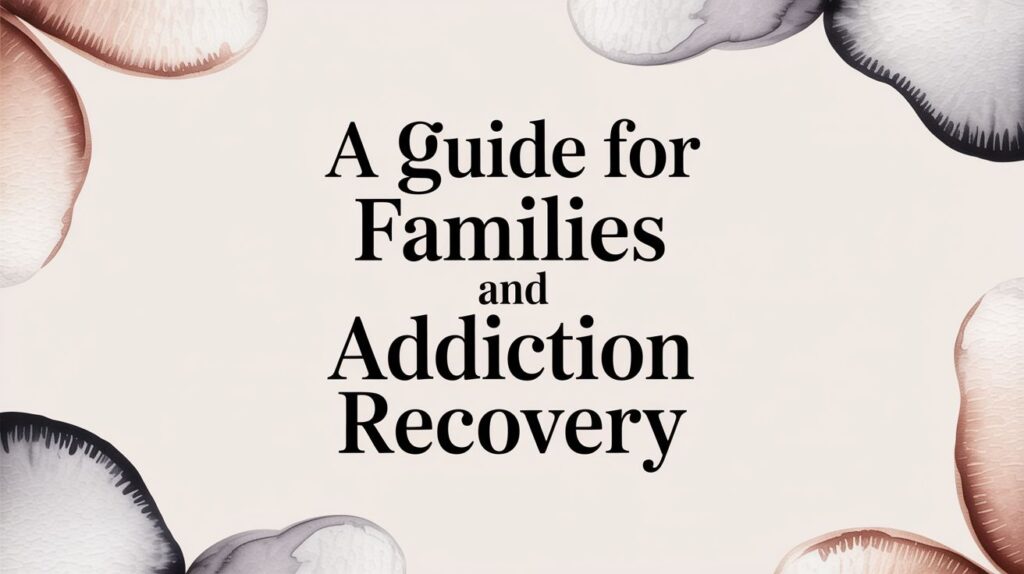The biggest difference between inpatient and outpatient rehab comes down to two things: where you sleep and how intense the care is. Think of inpatient rehab as a total immersion experience—you live at the treatment center 24/7, away from daily triggers, in a completely structured and supportive environment.
On the other hand, outpatient rehab lets you live at home and weave treatment into your existing life. You attend therapy sessions at a clinic but continue managing work, family, and school responsibilities.
Understanding Your Core Rehab Options
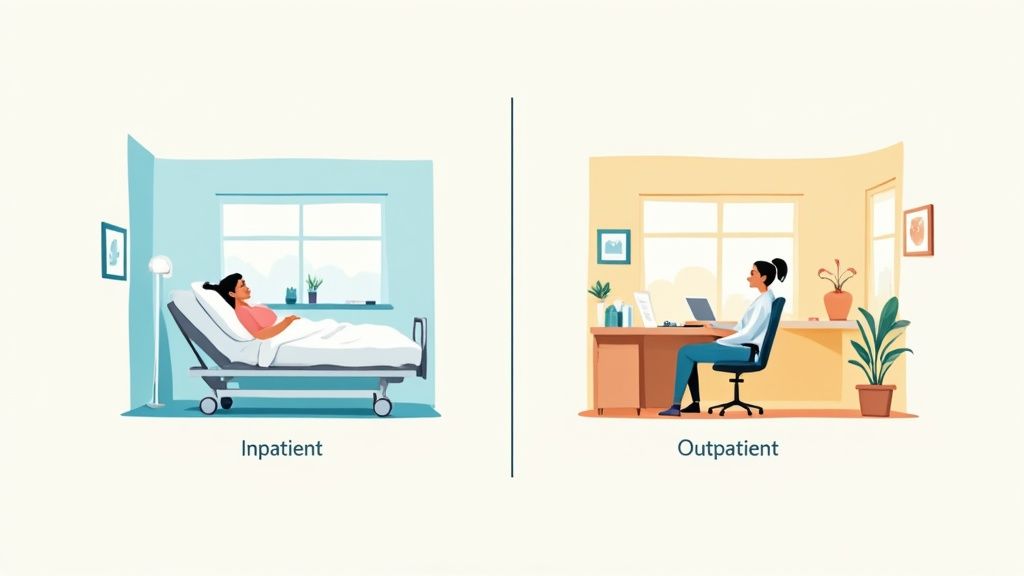
Choosing the right path to recovery is one of the most significant decisions you or a loved one will ever make. While both inpatient and outpatient programs rely on evidence-based therapies, they're built for very different situations. The best fit really depends on the severity of the substance use, the stability of your home life, and your personal commitments.
The core distinction lies in the environment: Inpatient rehab removes you from potential triggers entirely, while outpatient rehab teaches you to manage those triggers in real time.
This guide will break down both paths, giving you the clarity needed to figure out which one aligns best with your circumstances.
Inpatient vs Outpatient Rehab At a Glance
To make the initial decision a little less overwhelming, it helps to see a simple, side-by-side comparison of the two main models of care. Each one serves a distinct purpose on the recovery journey.
Here’s a quick look at how these two approaches stack up.
| Feature | Inpatient Rehab (Residential) | Outpatient Rehab (Non-Residential) |
|---|---|---|
| Living Arrangement | Live on-site at a dedicated facility 24/7 | Live at home and travel to a clinic for sessions |
| Time Commitment | Full-time, typically 30, 60, or 90 days | Part-time, a few hours per week to daily sessions |
| Ideal Candidate | Severe addiction, unstable home, co-occurring disorders | Mild to moderate addiction, strong support system |
This table provides a high-level snapshot, but the nuances of your own situation will ultimately guide your choice.
Treatment Popularity and Trends
The addiction treatment landscape shows a clear preference for more flexible models of care. Statistics reveal that outpatient services are by far the most common form of rehabilitation.
A 2019 report found that standard outpatient treatment accounted for 43% of all admissions, with intensive outpatient programs (IOPs) adding another 13%. In contrast, inpatient or residential care was offered by about 24% of facilities. This data really underscores the need for varied options that can meet people wherever they are in their journey.
Many programs, both inpatient and outpatient, also incorporate specialized methods to bolster recovery. For instance, you can learn more about medication-assisted treatment and see how it fits into either setting to support long-term success.
A Deep Dive into Inpatient Rehab Programs

Inpatient rehab, also known as residential treatment, is an immersive, highly structured environment built for one purpose: helping you focus completely on getting well. It works by physically removing you from the daily routines, stressors, and triggers that fuel substance use. Think of it as a safe harbor where you can begin to heal without the distractions and negative influences of your normal life.
The biggest advantage of inpatient care is the 24/7 medical and emotional support. This constant supervision is absolutely critical during the early days of detox, when withdrawal symptoms can be intense, unpredictable, and sometimes dangerous. Having immediate access to medical professionals ensures you are safe and as comfortable as possible, allowing them to manage any complications before they escalate.
But a structured setting is more than just a safe place to land. It's a carefully planned therapeutic community. Every part of the day, from meals and therapy to exercise and quiet time, is designed to rebuild healthy habits and restore the stability that active addiction so often takes away.
What Does a Typical Day Look Like
A day in inpatient rehab is intensive but also restorative, blending different therapies to treat you as a whole person. While every facility has its own rhythm, most follow a similar framework.
Your day might start with a healthy breakfast before moving into a morning group session, like a process group or a workshop on coping skills. Afternoons are often dedicated to individual counseling and specialized therapies like Cognitive Behavioral Therapy (CBT) or Dialectical Behavior Therapy (DBT).
Many programs also weave in holistic activities to support the mind-body connection. These often include:
- Mindfulness and Meditation: Practices that ground you in the present moment, helping you manage stress and ride out cravings.
- Yoga or Fitness Classes: Activities designed to heal the physical damage of addiction and reconnect you with your body.
- Art or Music Therapy: Creative outlets that provide a powerful way to express emotions that are too difficult to put into words.
Evenings might involve more group meetings, educational talks about relapse prevention, or quiet time for journaling. The whole point is to create a new, healthy rhythm that promotes self-discovery and healing, free from the chaos of the outside world.
The true power of inpatient rehab lies in its ability to create a "therapeutic bubble." By temporarily stepping away from your life, you gain the space and clarity needed to address the root causes of addiction without interruption.
Who Benefits Most from Inpatient Care
While anyone can benefit from this level of focus, inpatient rehab is especially effective for people facing significant, specific challenges. The immersive environment provides the high-level support needed for complex recovery situations.
Inpatient care is often the best path forward in these scenarios:
- Individuals with Severe Substance Use Disorders: For those with a long history of heavy use, a medically supervised setting is crucial for safely navigating withdrawal and preventing an immediate relapse.
- Those with Co-Occurring Disorders: When addiction is tangled up with mental health conditions like depression, anxiety, or PTSD (a dual diagnosis), integrated, round-the-clock care is vital for treating both issues at the same time.
- People with an Unsupportive Home Environment: If your living situation is full of triggers, high stress, or other people who are using, getting away from that environment is a critical first step toward building a new life.
- Individuals with a History of Relapse: For those who have tried other treatments without lasting success, the intensity and structure of an inpatient program can provide a much stronger foundation for recovery.
Programs are usually offered in 30, 60, or 90-day stays, which allows the treatment plan to be adapted to the severity of the addiction and your individual progress. After finishing an inpatient program, a solid step-down plan is essential. Many people find that moving into a supportive community is key to staying sober, and searching for options like "sober living near me" can be an invaluable part of that aftercare plan. This continued support helps bridge the gap between intensive residential care and returning to independent life.
How Outpatient Rehab Integrates Recovery with Life
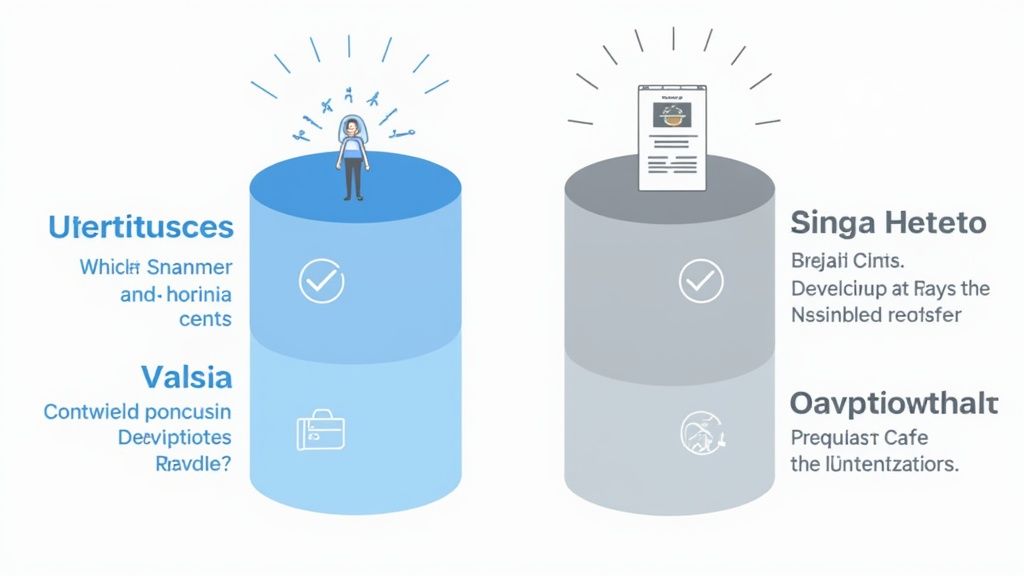
While inpatient programs create a protective bubble for healing, outpatient rehab is built to weave recovery directly into the fabric of your daily life. The whole point is to let you live at home, keep up with work or school, and stay present for your family—all while getting structured, professional care. It’s a model designed for real-world application, where you immediately put new coping skills to the test.
Think of it as an immediate feedback loop. You discuss how to manage workplace stress in a therapy session, then go to your job the next day and actually practice those techniques. This hands-on approach helps solidify new, healthy habits in a way that’s tough to replicate in a residential setting. Recovery becomes an active part of your everyday existence, not something you practice in isolation.
Of course, this approach hinges on having a stable and supportive home environment. If you don't have a safe place to return to after sessions, the risk of encountering triggers and relapsing is significantly higher. A strong network of encouraging family and friends is almost always a key ingredient for lasting success.
Different Levels of Outpatient Care
Not all outpatient programs are created equal. They exist on a spectrum, offering different levels of intensity to match a person's specific needs. Understanding these tiers is crucial when weighing the outpatient vs. inpatient rehab decision.
- Standard Outpatient Programs (OP): This is the least intensive option, usually involving just one or two therapy sessions per week. It’s a great fit for individuals with a mild substance use disorder or as a final "step-down" after completing a more intensive program.
- Intensive Outpatient Programs (IOP): An IOP provides a much higher level of care, typically requiring 9 to 20 hours of treatment each week, spread across several days. This offers a more robust structure while still giving you the flexibility to manage your outside commitments.
- Partial Hospitalization Programs (PHP): As the most intensive outpatient option, PHPs are sometimes called "day treatment." They can involve up to 30 hours of programming a week, closely mirroring the therapeutic intensity of an inpatient program but allowing you to go home each evening.
The growth of these flexible models reflects a broader shift in how we approach rehabilitation. The global outpatient rehab market is expected to hit USD 103.14 billion in 2025 and is projected to climb to USD 148.83 billion by 2030. This expansion is largely driven by better insurance coverage and advances in tele-rehabilitation, making outpatient care an increasingly cost-effective and accessible path to recovery. You can find more details on the growth of the outpatient centers market on Mordor Intelligence.
The core principle of outpatient rehab is empowerment. It trusts you to take the tools learned in therapy and actively apply them, turning everyday challenges into opportunities for growth and resilience.
Ideal Candidates for Outpatient Treatment
Outpatient rehab is a powerful path to recovery, but it’s most effective for people in specific circumstances. It's not just about the severity of an addiction; it’s about the entire ecosystem of a person’s life.
Consider these real-world scenarios where outpatient care often makes the most sense:
The Working Professional: A manager with a stable career and supportive family has started relying on alcohol to cope with work stress. Taking 30-90 days off from their job isn't an option. An evening IOP allows them to get intensive treatment without putting their career on the line.
The Primary Caregiver: A parent is the sole caregiver for their young children, making it impossible to leave for a month or more for inpatient care. A flexible outpatient program lets them attend therapy while their kids are in school, ensuring their family stays supported.
The Motivated Individual Stepping Down: Someone has just finished a 30-day inpatient program and needs continued support as they navigate their return to daily life. An outpatient program offers the perfect transition, providing structure and accountability as they reintegrate. For those in Texas, exploring options for an outpatient drug rehab in Houston can be a crucial next step in building a sustainable recovery.
Comparing Key Factors in Your Rehab Decision
Choosing between inpatient and outpatient rehab isn't about picking the "better" option—it's about finding the right fit for your specific life circumstances, clinical needs, and personal responsibilities. The best way to get clear on this crucial decision is to put them side-by-side.
By breaking down how each model works in the real world, you can start to see the trade-offs and figure out where you land. We'll compare them across four critical areas: treatment intensity, cost, daily flexibility, and the type of peer support you'll get.
Treatment Intensity and Structure
The biggest difference between the two is the environment. Inpatient rehab is a total immersion. You live on-site in a 24/7 therapeutic setting where every moment is structured—from morning meditation and group sessions to individual counseling. The goal is to remove you from outside triggers and distractions so you can focus entirely on healing.
Outpatient rehab, on the other hand, delivers structured treatment that fits into your existing life. You’ll find intensive options like Partial Hospitalization Programs (PHPs) or Intensive Outpatient Programs (IOPs) that pack in a high number of therapy hours each week, but you go home every night. This approach demands a lot more self-discipline, since you’re applying recovery skills in real-time while navigating daily life.
Key Insight: Inpatient rehab controls the environment to protect your recovery, while outpatient rehab teaches you to protect your recovery within your existing environment. The choice really boils down to whether you need a complete break from your triggers or you need to learn how to manage them right where you are.
The infographic below really drives home the differences in time and financial commitment.
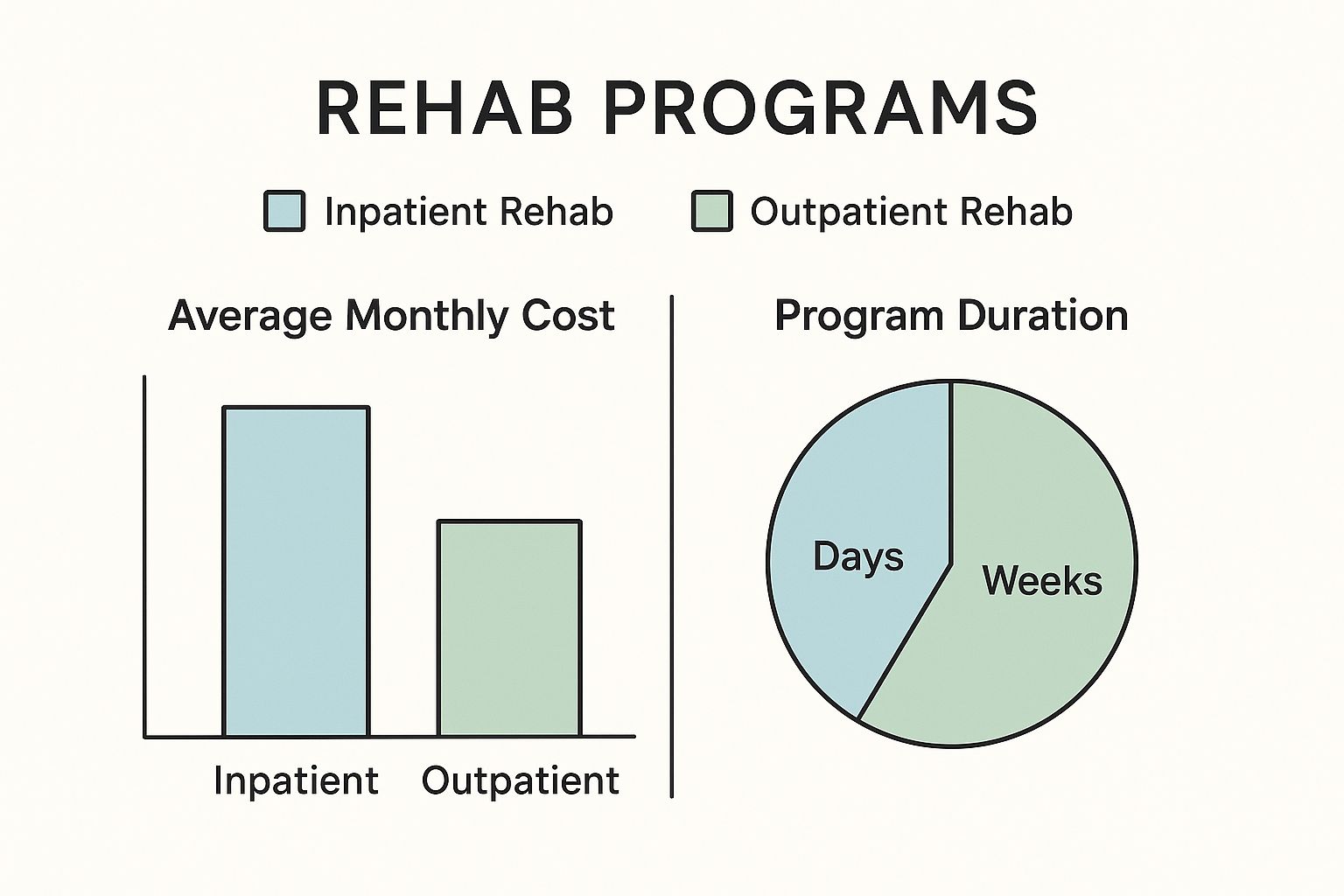
As you can see, inpatient care is a much bigger upfront investment of both time and money because it’s an all-inclusive, residential experience.
Cost and Insurance Considerations
Money is a huge part of the conversation. Inpatient programs are significantly more expensive because the price tag covers a whole ecosystem of care, not just therapy. You're paying for:
- 24/7 Medical and Clinical Staffing: Around-the-clock access to nurses, doctors, and support staff.
- Accommodation and Lodging: This is the room and board component.
- Meals and Nutrition: All your meals are provided, often planned by nutritionists to help your body heal.
- Facility Amenities: Things like fitness centers, quiet spaces, and other on-site resources.
Outpatient care is far more affordable because it strips away all those residential costs. You're only paying for the clinical services you use, which makes it a much more accessible option for many people. While insurance usually covers both, how much it covers can vary wildly. Getting a clear picture of your policy is a must. For a deeper look, our guide on insurance coverage for addiction treatment can help you figure out what to expect.
Daily Life Flexibility
This is where outpatient programs really have the edge. If you have a job you can't leave, school commitments, or kids to take care of, an outpatient program is designed to work around your life. You can schedule therapy sessions for evenings or weekends, letting you keep up with your daily routine.
Inpatient rehab requires you to hit pause on everything. You'll need to take a leave of absence from work, arrange for childcare, and step away from all your other obligations for the entire stay—usually 30, 60, or 90 days. For some, that complete separation is exactly what’s needed to build a foundation for recovery. For others, it’s a logistical non-starter.
Level of Peer Support
Both models provide peer support, but it looks and feels very different. In an inpatient facility, you live with your peers. You're sharing meals, going to therapy, and spending downtime together, which forges incredibly tight bonds through an intense, shared experience. That built-in, 24/7 support network can be a game-changer, especially in the rocky early days.
In an outpatient setting, peer support is built mostly during group therapy. These connections are absolutely valuable, but they're limited to the hours you spend at the center. The rest of the time, your support system is the network you have at home—family, sober friends, and sponsors. The success of outpatient treatment often hinges on how strong and stable that external support system is.
For a clearer, more direct comparison, the table below breaks down the key decision factors to help you weigh your options.
Detailed Feature Comparison Inpatient vs Outpatient
| Decision Factor | Inpatient Rehab Analysis | Outpatient Rehab Analysis | Best For… |
|---|---|---|---|
| Structure & Intensity | 24/7 structured environment with constant supervision and no outside distractions. Highly intensive. | Scheduled therapy for several hours, multiple days a week. Client manages free time. | Inpatient: Severe SUD, high relapse risk, or unstable home life. |
| Living Situation | Reside at the facility for the entire duration of the program (30-90 days). | Live at home or in a sober living facility and commute to treatment. | Outpatient: Strong home support system and ability to manage triggers. |
| Flexibility | Requires a complete pause on work, school, and family obligations. | Allows clients to maintain their job, attend school, and care for family. | Outpatient: Individuals who cannot step away from their daily responsibilities. |
| Cost | Significantly higher due to costs for lodging, meals, and 24/7 staffing. | More affordable as it only covers the cost of clinical services. | Outpatient: Those with budget constraints or less comprehensive insurance. |
| Peer Support | Immersive, creating a tight-knit community through shared living and constant interaction. | Built during group therapy sessions; relies on external networks outside of treatment hours. | Inpatient: Individuals who need a strong, built-in support system from day one. |
| Medical Supervision | Around-the-clock medical and psychiatric care is available on-site for detox and co-occurring issues. | Medical support is available during program hours but not 24/7. Detox often happens separately. | Inpatient: Complicated withdrawal, co-occurring medical conditions, or dual diagnosis needs. |
This side-by-side view should help clarify which path aligns better with your current needs. There's no single right answer, only the one that gives you the strongest possible start on your recovery journey.
So, Which Program is Actually Right for You?
Choosing between inpatient and outpatient rehab isn’t about picking the “better” option—it’s about picking the right tool for the job. The best path forward hinges on a brutally honest look at your life right now: the severity of the addiction, the stability of your home life, and the responsibilities you can’t just walk away from.
To make this less abstract, let’s walk through a couple of real-world scenarios. Think of these as frameworks for seeing your own situation more clearly, not boxes to fit into. Recognizing the patterns is what helps point you toward the right level of care.
The College Student with a Growing Problem
Picture "Sarah," a 20-year-old whose weekend partying has quietly spiraled into a daily habit. Her grades are starting to slide, and her family is worried about how much she’s changed. But here’s the key: Sarah has a solid, loving family nearby, a safe place to live, and no history of dangerous withdrawal symptoms.
For Sarah, outpatient rehab is almost certainly the smartest move. Here’s why:
- It Fits Her Life: She can keep up with her classes while hitting therapy sessions in the evenings or on weekends. No need to torpedo her education.
- Leverages Her Support System: Her family can jump right in, joining family therapy and helping keep her accountable at home. That's a huge asset.
- Real-World Practice: She gets to test-drive coping skills immediately, applying what she learns in therapy to the actual pressures she faces on campus.
Outpatient care lets Sarah build recovery skills in the environment where she actually lives, which is a massive advantage for making sobriety stick.
The Executive with a Long-Term, Hidden Addiction
Now, meet "David," a 45-year-old executive whose high-stress career is fueled by a long-term, high-functioning addiction to alcohol. He’s kept his job, but his health is failing and his relationships are cracking under the strain. His work environment is one giant trigger, and he needs total privacy to finally get well.
For David, inpatient rehab provides the focused, structured environment he needs to heal.
- A Clean Break from Triggers: A residential facility yanks him out of the daily grind and away from the cues—the stressful meetings, the after-work drinks—that drive his addiction.
- Medical Safety: After years of heavy drinking, quitting cold turkey is dangerous. He needs 24/7 medical supervision to detox safely and manage severe withdrawal symptoms.
- Total Immersion and Privacy: Inpatient care offers a confidential space where he can dig into the root causes of his addiction without worrying about work emails or home life distractions.
This immersive, focused approach gives David the time and sanctuary required to tackle the deep-seated issues that have been building for years.
The choice often boils down to this: Do you need to learn how to manage triggers while living your life (outpatient), or do you need to be completely removed from those triggers to begin healing (inpatient)?
How to Evaluate Your Own Situation
Where you are in life plays a huge role in what kind of care will work best. For instance, comparative international data shows that age is a major factor in treatment recommendations. Younger patients are often discharged home with strong outpatient support, while older individuals may need the intensive structure of inpatient or long-term care. You can read the full research about these care pathway findings to see how personal factors shape these decisions.
To figure out your best fit, ask yourself these questions—and be honest:
- How severe is the substance use? Have there been relapses, overdoses, or serious withdrawal symptoms in the past?
- Is my home environment stable and supportive? Or is it a source of constant stress and temptation?
- Am I also dealing with mental health issues? Conditions like depression, anxiety, or PTSD often need the kind of integrated, intensive care found in inpatient programs.
- Can I realistically hit pause on my job or family responsibilities? If the answer is no, a flexible outpatient program might be the only practical starting point.
Answering these questions will give you the clarity you need to choose the program that offers the strongest shot at a lasting recovery.
What’s the Next Step on Your Recovery Journey?
Making a choice between outpatient and inpatient rehab is a huge step forward, but it’s just the beginning. Now it’s time to turn what you’ve learned into a clear, actionable plan. This isn’t about making a perfect decision overnight; it’s about taking thoughtful steps with professional guidance to find the right starting point for your recovery.
You don’t have to figure this all out alone. The insights you’ve gained from this guide are your foundation, but the next phase is best handled with an expert. A supportive, empowering approach will help you move forward with real confidence.
Creating Your Action Plan
With the information you now have, you can start building a clear path forward. The goal is to gather all the key details so you can make an empowered choice alongside a healthcare professional.
Your immediate next steps should include these three things:
Do an Honest Self-Assessment: Go back through the key factors we've discussed—the severity of the addiction, your home environment, any co-occurring disorders, and your daily responsibilities. Be real with yourself and write down where you stand on each. This clarity will be invaluable when you first speak with a specialist.
Schedule a Clinical Evaluation: This is the single most important step you can take. An addiction specialist or licensed clinician will give you a professional assessment. They’ll look at your medical history and specific needs to recommend the right level of care, taking all the guesswork out of your decision.
Review Your Insurance Benefits: Call your insurance provider directly to get a clear picture of what’s covered for both inpatient and outpatient treatment. Ask specific questions about deductibles, co-pays, and pre-authorizations to avoid any financial surprises down the road.
The most crucial takeaway is this: you are not expected to be an expert on your own treatment. Your role is to be open and honest during an evaluation; a professional's job is to guide you to the safest, most effective level of care for your situation.
Finding the Right Treatment Center
Once you have a clinical recommendation in hand, you can start looking at potential facilities. Zero in on centers that offer the level of care you need and specialize in your specific situation, such as dual diagnosis treatment or trauma-informed therapy.
Remember, choosing the right kind of rehab is a foundational act of self-care. It sets the stage for building the resilience, coping skills, and support system you'll need for a lasting recovery. By taking these methodical steps, you are actively building a stronger future, one decision at a time.
Frequently Asked Questions About Rehab
Stepping into the world of addiction treatment brings up a lot of real-world questions. Making the right call between outpatient vs. inpatient rehab means getting clear on the practical stuff, like how insurance works, how you move between programs, and what life looks like after that first phase of care is over.
Let’s get straight to the answers for some of the most common questions we hear. Understanding these details helps pull back the curtain on the whole process, so you can choose a path that fits both your clinical needs and your life.
Can I Switch from Inpatient to Outpatient Care?
Yes, and you absolutely should. Moving from inpatient to outpatient care isn’t just possible—it’s a standard and highly recommended part of any solid recovery plan. This transition is known as a “step-down” process, and it’s a crucial piece of what we call the continuum of care. The whole point is to help you gradually ease back into daily life with a strong support system still in place.
Think about it: going straight from a 24/7 structured environment right back home with no support can be a shock to the system. A step-down plan softens that landing by moving you into programs like:
- Partial Hospitalization Program (PHP): This is the most intensive outpatient option. It offers a level of structure that feels a lot like inpatient care, but you get to live at home.
- Intensive Outpatient Program (IOP): A strong, flexible choice that includes several therapy sessions per week while you manage work or family.
- Standard Outpatient Program (OP): Usually the final step, involving weekly therapy sessions to keep you accountable and on track.
This gradual approach is designed to help you practice and solidify the skills you learned in residential treatment, which dramatically lowers the risk of relapse.
How Can I Find Out If My Insurance Covers Rehab?
Figuring out what your insurance will cover is one of the very first steps, and thankfully, it's straightforward. The most direct route is to call the member services number on the back of your insurance card. When you get a representative on the line, ask specifically about your benefits for "substance use disorder treatment" and "mental health services."
To get the clearest picture, have a few targeted questions ready:
- What’s my deductible for facilities that are in-network versus out-of-network?
- Do I have a limit on the number of days you’ll cover for inpatient or outpatient care?
- Do I need pre-authorization before I can start treatment?
Most treatment centers have admissions coordinators who will do this for you. This is often the easiest path. They’re experts at navigating insurance jargon and can break down your coverage in simple, clear terms.
What Happens After Rehab Ends?
Recovery doesn’t have a finish line. When your formal program ends, the next phase is just beginning. Life after rehab is all about putting your aftercare plan into action—a personalized strategy designed to support your long-term sobriety. Honestly, this is one of the most important parts of the entire process.
A good aftercare plan isn’t just one thing; it’s a combination of ongoing support systems that help you handle triggers and keep your momentum going. The key pieces usually include:
- Continued Therapy: Regular check-ins with a therapist to work through ongoing challenges.
- Support Groups: Active participation in groups like Alcoholics Anonymous (AA), Narcotics Anonymous (NA), or SMART Recovery.
- Sober Living Homes: A structured, drug-free home that acts as a bridge between the intensity of inpatient care and the freedom of independent living.
The goal is simple: to build a resilient support network that makes sobriety a sustainable, natural part of your new life.
At Altura Recovery, we know the journey to recovery happens one step at a time. Our comprehensive outpatient programs give you the support and flexibility needed to build a lasting foundation for sobriety while still managing your daily life. If you’re ready to take that next step, contact us to learn more about our personalized treatment plans.



